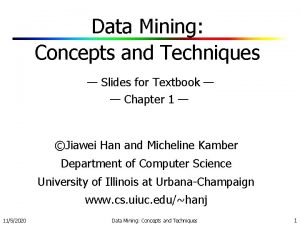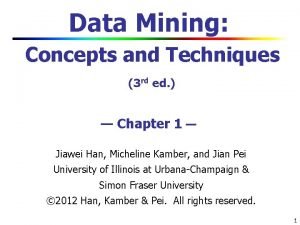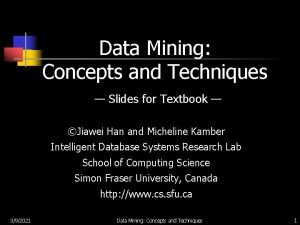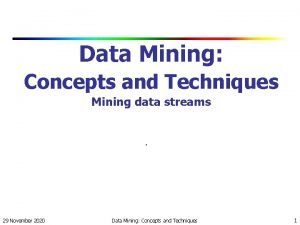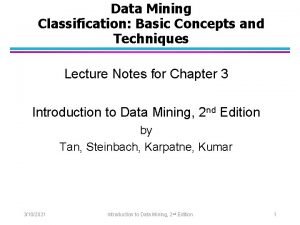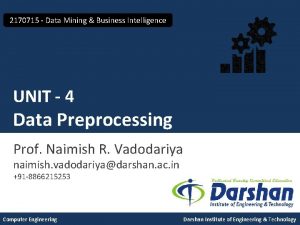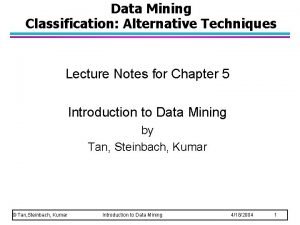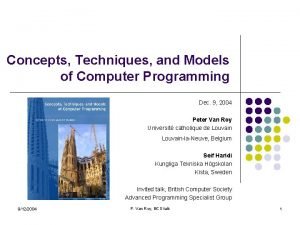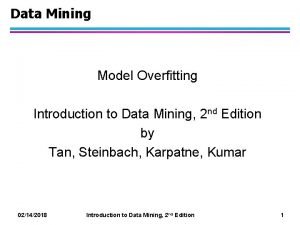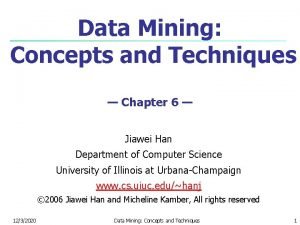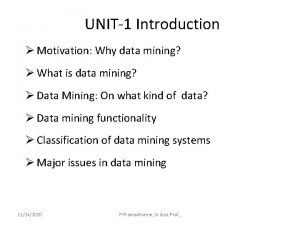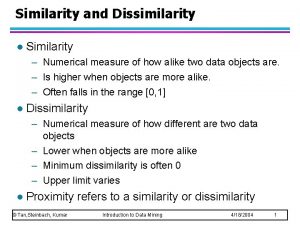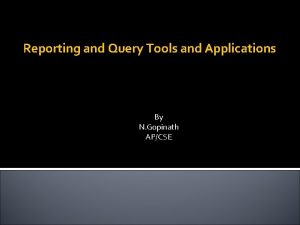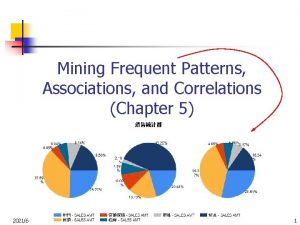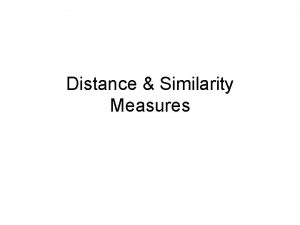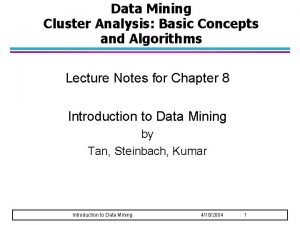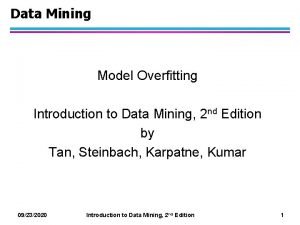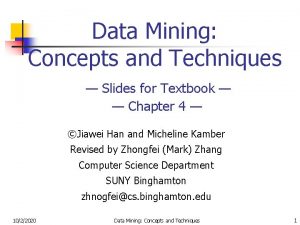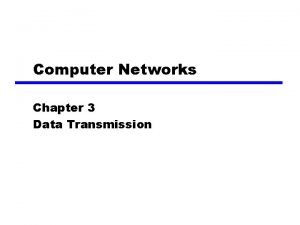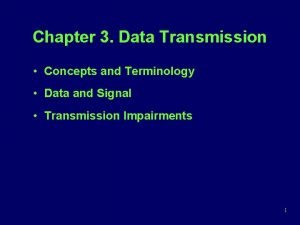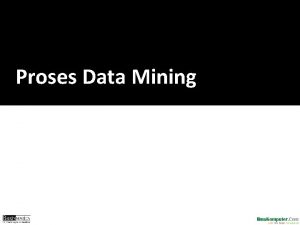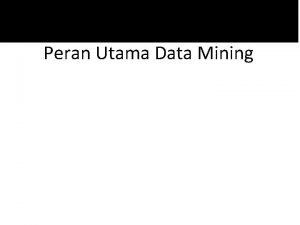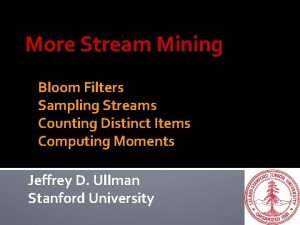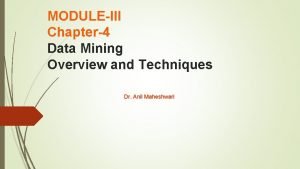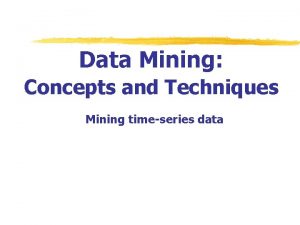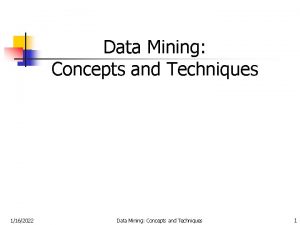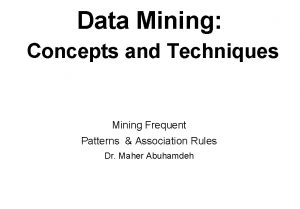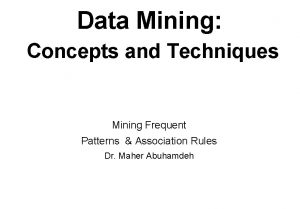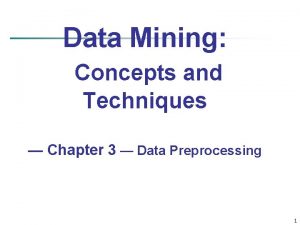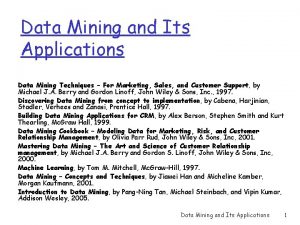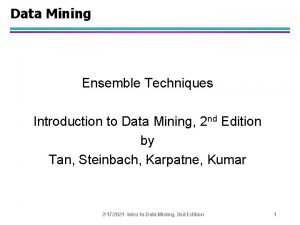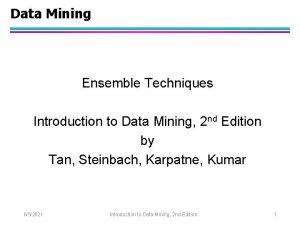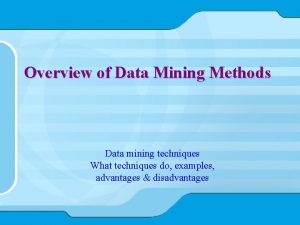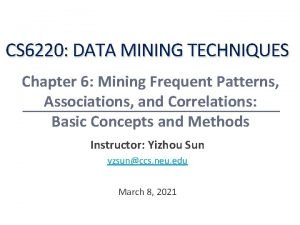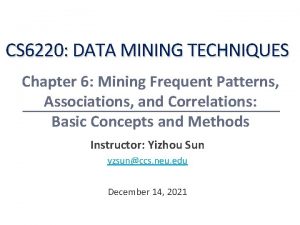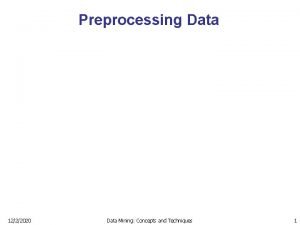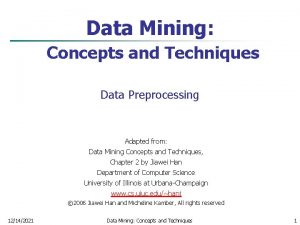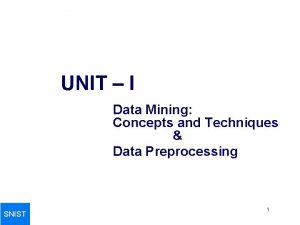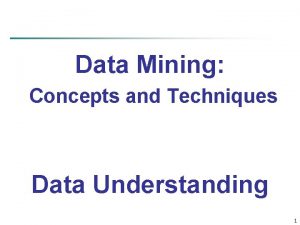Data Mining Concepts and Techniques Chapter 11 Data










































































- Slides: 74

Data Mining: Concepts and Techniques — Chapter 11 — — Data Mining and Intrusion Detection — Jiawei Han and Micheline Kamber Department of Computer Science University of Illinois at Urbana-Champaign www. cs. uiuc. edu/~hanj © 2006 Jiawei Han and Micheline Kamber. All rights reserved. Acknowledgements: Jian Pei and Huiping Chen (Spring 2004) 2021/6/3 Data Mining: Principles and Algorithms 1

Outline n Intrusion detection and computer security n Current intrusion detection approaches n Data Mining Approaches for Intrusion Detection n Summary 2021/6/3 Data Mining: Principles and Algorithms 2

Intrusion Detection and Computer Security n Computer security goals: n n Confidentiality, integrity, and availability Intrusion is a set of actions aimed to compromise these security goals n Intrusion prevention (authentication, encryption, etc. ) alone is not sufficient n Intrusion detection is needed 2021/6/3 Data Mining: Principles and Algorithms 3

Intrusion Examples n Intrusions: Any set of actions that threaten the integrity, availability, or confidentiality of a network resource n Examples n n 2021/6/3 Denial of service (Do. S): attempts to starve a host of resources needed to function correctly Scan: reconnaissance on the network or a particular host Worms and viruses: replicating on other hosts Compromises: obtain privileged access to a host by known vulnerabilities Data Mining: Principles and Algorithms 4

Intrusion Detection n Intrusion detection: The process of monitoring and analyzing the events occurring in a computer and/or network system in order to detect signs of security problems Primary assumption: User and program activities can be monitored and modeled Steps n Monitoring and analyzing traffic n Identifying abnormal activities n Assessing severity and raising alarm 2021/6/3 Data Mining: Principles and Algorithms 5

Monitoring and Analyzing Traffic n TCPdump and Windump n n Provide insight into the traffic activity on a network n ftp: //ftp. ee. lbl. gov/tcpdump. tar. Z n http: //netgroupserv. polito. it/windump Ethereal n 2021/6/3 GUI to interpret all layers of the packet Data Mining: Principles and Algorithms 6

Goals of Intrusion Detection System (IDS) n Detect wide variety of intrusions n n n Previously known and unknown attacks Suggests need to learn/adapt to new attacks or changes in behavior Detect intrusions in timely fashion n May need to be real-time, especially when system responds to intrusion n n 2021/6/3 Problem: analyzing commands may impact response time of system May suffice to report intrusion occurred a few minutes or hours ago Data Mining: Principles and Algorithms 7

Goals of Intrusion Detect. System (IDS) (2) n Present analysis in simple, easy-to-understand format n Be accurate n Minimize false positives, false negatives n False positive: An event, incorrectly identified by the IDS as being an intrusion when none has occurred n False negative: An event that the IDS fails to identify as an intrusion when one has in fact occurred n 2021/6/3 Minimize time spent verifying attacks, looking for them Data Mining: Principles and Algorithms 8

IDS Architecture n n n Sensors (agent) n to collect data and forward info to the analyzer n network packets n log files n system call traces Analyzers (detector) n To receive input from one or more sensors or from other analyzers n To determine if an intrusion has occurred User interface n To enable a user to view output from the system or control the behavior of the system 2021/6/3 Data Mining: Principles and Algorithms 9

IDS Architecture 2021/6/3 Data Mining: Principles and Algorithms 10

Signature-Based Intrusion Detection n Human analysts investigate suspicious traffic n Extract signatures n Features of known intrusions n Use pre-defined signatures to discover malicious packets n Examples n La. Brea Tarpit by Tom Liston n Snort and Snort rules Marty Roesch 2021/6/3 Data Mining: Principles and Algorithms 11

Snort by Marty Roesch n An open source free network intrusion detection system n n Signature-based, use a combination of rules and preprocessors n On many platforms, including UNIX and Windows n www. snort. org Preprocessors n n 2021/6/3 IP defragmentation, port-scan detection, web traffic normalization, TCP stream reassembly, … Can analyze streams, not only a single packet at a time Data Mining: Principles and Algorithms 12

Snort—Overview n Typical run from the command line n n Modes n Sniff: dump sniffed traffic to the screen n Packet log: log the packets to the disk n n GUI available by IDScenter/Demarc/Puresecure NIDS: compare the network traffic with a preconfigured set of signatures Output can be stored into spool files or a database 2021/6/3 Data Mining: Principles and Algorithms 13

Snort Rules n Two parts n Rule header: define who must be involved n Rule options: define what must be involved (action) Rule header alert tcp !1. 2. 3. 0/24 any -> 1. 2. 3. 0/24 any n n Rule options (flags: SF; msg: ”SYN-FIN scan; ) The rule triggers when an outsider attempt to make an internal TCP connection If both SYN and FIN are set, a message of “SYN-FIN scan” is reported with the alert 2021/6/3 Data Mining: Principles and Algorithms 14

Application of Snort Rules n A packet triggers the first rule that matches and does not examine the remainder n The ordering of rules is critical n Each Snort rule inspects only one packet n Use preprocessors such as IP defragmentation or TCP stream reassembly to handle a series of packets 2021/6/3 Data Mining: Principles and Algorithms 15

Snort Rule Sets n Snort comes with a very large set of rules n n Not recommended that all rules used on installation New Snort rules are released as soon as hours after a new exploit is discovered n A new rule may not be a good rule n The attackers may change the signatures easily 2021/6/3 Data Mining: Principles and Algorithms 16

Snort and Event Viewer on NT 2021/6/3 Data Mining: Principles and Algorithms 17

Problems in Signature-Based Intrusion Detection Systems n Many false positives: prone to generating alerts when there is no problem in fact n Signatures are not specific enough n A packet is not examined in context with those that precede it or those that follow n Cannot detect unknown intrusions n 2021/6/3 Rely on signatures extracted by human experts Data Mining: Principles and Algorithms 18

Misuse vs. Anomaly Detection n Misuse detection: use patterns of well-known attacks to identify intrusions n Classification based on known intrusions n E. g. , three consecutive login failures: password guessing. n Anomaly detection: use deviation from normal usage patterns to identify intrusions n Any significant deviations from the expected behavior are reported as possible attacks 2021/6/3 Data Mining: Principles and Algorithms 19

Misuse vs. Anomaly Detection Definition Misuse Detection Anomaly Detection matching the sequence of “signature actions” of known intrusion scenarios using statistical measure on system features Shortcoming n n Example STAT [HLMS 90] IDES [LTG+92] 2021/6/3 Has to hand-coded known pattern. n Unable to detect any future intrusion Rely upon in selecting the system features. n Has to study sequential interrelation between transactions Data Mining: Principles and Algorithms 20

Host-based vs. Network-based n n According to data sources Host-based detection: the data is collected from an individual host n n n Directly monitor the host data files and OS processes Can determine exactly which host resources are the targets of a particular attack Network-based detection: the data is traffic across the network n n 2021/6/3 A set of traffic sensors within the network Can easily harder against attacks and hide from the attackers Data Mining: Principles and Algorithms 21

OUTLINE n Intrusion detection and computer security n Current intrusion detection approaches n n 2021/6/3 Data Mining Approaches for Intrusion Detection Summary Data Mining: Principles and Algorithms 22

Current Intrusion Detection Approaches—Misuse Detection n Misuse detection : n n 2021/6/3 Record the specific patterns of intrusions Monitor current audit trails (event sequences) and pattern matching Report the matched events as intrusions Representation models: expert rules, Colored Petri Net, and state transition diagrams, etc. Data Mining: Principles and Algorithms 23

Misuse Detection Example n Expert systems: use a set of rules to describe attacks n n Signature analysis: capture features of attacks in audit trail n n IDES, Computer. Watch, NIDX, P-BEST, ISOA Haystack, Net. Ranger, Real. Secure, Mu. Sig State-transition analysis: use state-transition diagrams STAT, USTAT and Net. STAT Other approaches n Colored petri nets, e. g. , IDIOT n Case-based reasoning, e. g. , AUTOGUARD n n 2021/6/3 Data Mining: Principles and Algorithms 24

Current Intrusion Detection Approaches—Anomaly Detection n Anomaly detection: n Establishing the normal behavior profiles n Observing and comparing current activities with the (normal) profiles n Reporting significant deviations as intrusions n Statistical measures as behavior profiles: ordinal and categorical (binary and linear) 2021/6/3 Data Mining: Principles and Algorithms 25

Anomaly Detection Example n n Statistical methods: multivariate, temporal analysis n IDES, NIDES, EMERALD Expert systems n Computer. Watch, Wisdom & Sense 2021/6/3 Data Mining: Principles and Algorithms 26

Problems of Current Intrusion Detection Approaches n Main problems: manual and ad-hoc n Misuse detection: n n n Unable to detect any new intrusions (that have no matched patterns recorded in the system) Anomaly detection: n n 2021/6/3 Known intrusion patterns have to be hand-coded Selecting the right set of system features to be measured is ad hoc and based on experience Unable to capture sequential interrelation between events Data Mining: Principles and Algorithms 27

OUTLINE n n 2021/6/3 Intrusion detection and computer security Current intrusion detection approaches Data Mining Approaches for Intrusion Detection Summary Data Mining: Principles and Algorithms 28

Data Mining Approaches for Intrusion Detection n A systematic framework n Why Can Data Mining Help? n Relevant data mining techniques n Building Classifiers for Intrusion Detection n Mining Patterns from Audit Data 2021/6/3 Data Mining: Principles and Algorithms 29

A Systematic Framework—J. Stolfo et al. n Build good models: n n Build better models: n n select appropriate features of audit data to build intrusion detection models architect a hierarchical detector system that combines multiple detection models Build updated models: n 2021/6/3 dynamically update and deploy new detection system as needed Data Mining: Principles and Algorithms 30

A Systematic Framework n Support for the feature selection and model construction: n Apply data mining algorithms to find consistent interand intra- audit record (event) patterns n Use the features and time windows in the discovered patterns to build detection models n 2021/6/3 A support environment to semi-automate this process Data Mining: Principles and Algorithms 31

A Systematic Framework n n Combining multiple detection models: n Each (base) detector model monitors one aspect of the system n They can employ different techniques and be independent of each other n The learned (meta) detector combines evidence from a number of base detectors An intelligent agent-based architecture: n learning agents: continuously compute (learn) the detection models n detection agents: use the (updated) models to detect intrusions 2021/6/3 Data Mining: Principles and Algorithms 32

A Systematic Framework 2021/6/3 Data Mining: Principles and Algorithms 33

Data Mining Approaches for Intrusion Detection n A systematic framework n Why Can Data Mining Help? n n n 2021/6/3 Relevant data mining techniques Building Classifiers for Intrusion Detection Mining Patterns from Audit Data Mining: Principles and Algorithms 34

Why Can Data Mining Help? n n n Data mining: applying specific algorithms to extract patterns from data Normal and intrusive activities leave evidence in audit data From the data-centric point view, intrusion detection is a data analysis process 2021/6/3 Data Mining: Principles and Algorithms 35

Why Can Data Mining Help? n n n 2021/6/3 Successful applications in related domains, e. g. , fraud detection, fault/alarm management Learn from traffic data n Supervised learning: learn precise models from past intrusions n Unsupervised learning: identify suspicious activities Maintain or update models on dynamic data Data Mining: Principles and Algorithms 36

Data Mining Approaches for Intrusion Detection n A systematic framework Why Can Data Mining Help? n Relevant data mining techniques n n n 2021/6/3 Building Classifiers for Intrusion Detection Mining Patterns from Audit Data Mining: Principles and Algorithms 37

Frequent Patterns n Patterns that occur frequently in a database n Mining Frequent patterns – finding regularities n Process of Mining Frequent patterns for intrusion detection n n 2021/6/3 Phase I: mine a repository of normal frequent itemsets for attack-free data Phase II: find frequent itemsets in the last n connections and compare the patterns to the normal profile Data Mining: Principles and Algorithms 38

Frequent Pattern Mining in MINDS: a IDS using data mining techniques n n University of Minnesota Summarizing attacks using association rules n 2021/6/3 {Src IP=206. 163. 27. 95, Dest Port=139, Bytes [150, 200)} {ATTACK} Data Mining: Principles and Algorithms 39

Patterns About Alerts n n n Ning et al. CCS’ 02 Find correlated alerts – the frequent patterns of alerts n Attack scenarios – the logical connections between alerts n A hyper-alerts correlation graph approach Use the correlation of intrusion alerts to identify high level attacks 2021/6/3 Data Mining: Principles and Algorithms 40

Associate rules n Used for link analysis n E. g. : n n 2021/6/3 If the number of failed login attempts (num_failed_login_attempts) and the network service on the destination (service) are features, an example of rule is: num_failed_login_attempts = 6, service = FTP => attack = Do. S [1, 0. 28 ] Data Mining: Principles and Algorithms 41

Sequential Pattern Analysis n Models sequence patterns n (Temporal) order is important in many situations n n Time-series databases and sequence databases n Frequent patterns (frequent) sequential patterns Sequential patterns for intrusion detection n Capture the signatures for attacks in a series of packets 2021/6/3 Data Mining: Principles and Algorithms 42

Classification: A Two-Step Process n Model construction: describe a set of predetermined classes n Training dataset: tuples for model construction n Each tuple/sample belongs to a predefined class Classification rules, decision trees, or math formulae Model application: classify unseen objects n n 2021/6/3 Estimate accuracy of the model using an independent test set Acceptable accuracy apply the model to classify data tuples with unknown class labels Data Mining: Principles and Algorithms 43

Classification Methods n n Basic Algorithm ID 3 Neural networks Bayesian classification n Naïve Bayesian classification n Bayesian belief network Support vector machines 2021/6/3 Data Mining: Principles and Algorithms 44

Classification for Intrusion Detection n Misuse detection n n Classification based on known intrusions Example: Sinclair et al. “An application of machine learning to network intrusion detection” n n Use decision trees and ID 3 on host session data Use genetic algorithms to generate rules n 2021/6/3 If <pattern> then <alert> Data Mining: Principles and Algorithms 45

HIDE n n “A hierarchical network intrusion detection system using statistical processing and neural network classification” by Zheng et al. Five major components n Probes collect traffic data n Event preprocessor preprocesses traffic data and feeds the statistical model n Statistical processor maintains a model for normal activities and generates vectors for new events n Neural network classifies the vectors of new events n Post processor generates reports 2021/6/3 Data Mining: Principles and Algorithms 46

Intrusion Detection by NN and SVM n n n S. Mukkamala et al. , IEEE IJCNN May 2002 Discover useful patterns or features that describe user behavior on a system Use the set of relevant features to build classifiers SVMs have great potential to be used in place of NNs due to its scalability and faster training and running time NNs are especially suited for multi-category classification 2021/6/3 Data Mining: Principles and Algorithms 47

Clustering n Group data into clusters n What is a good clustering n High intra-class similarity and low inter-class similarity n n n Depending on the similarity measure The ability to discover some or all of the hidden patterns Clustering Approaches n K-means n Hierarchical Clustering n Density-based methods n Grid-based methods n Model-based 2021/6/3 Data Mining: Principles and Algorithms 48

Clustering for Intrusion Detection n Anomaly detection n Any significant deviations from the expected behavior are reported as possible attacks n Build clusters as models for normal activities n “A scalable clustering for intrusion signature recognition” by Ye and Li n 2021/6/3 Use description of clusters as signatures of intrusions Data Mining: Principles and Algorithms 49

Alert Correlation n F. Cuppens and A. Miege, in IEEE S&P’ 02 n Use clustering and merging functions to recognize alerts that correspond to the same occurrence of an attack n Create a new alert that merge data contained in these various alerts n Generate global and synthetic alerts to reduce the number of alerts further 2021/6/3 Data Mining: Principles and Algorithms 50

Mining Data Streams n Continuous arrival data in multiple, rapid, time-varying, possibly unpredictable and unbounded streams n Many applications n Financial applications, network monitoring, security, telecommunications data management, web application, manufacturing, sensor networks, etc. 2021/6/3 Data Mining: Principles and Algorithms 51

Mining Data Streams for Intrusion Detection n n Maintaining profiles of normal activities n The profiles of normal activities may drift Identifying novel attacks n Identifying clusters and outliers in traffic data streams 2021/6/3 Data Mining: Principles and Algorithms 52

Data Mining Approaches for Intrusion Detection n A systematic framework Why Can Data Mining Help? Relevant data mining techniques n Building Classifiers for Intrusion Detection n Mining Patterns from Audit Data n n 2021/6/3 Data Mining: Principles and Algorithms 53

Building Classifiers for Intrusion Detection—J. Stolfo et al. n n Experiments in constructing classification models for anomaly detection Two experiments: n n n sendmail system call data network tcpdump data Use meta classifier to combine multiple classification models 2021/6/3 Data Mining: Principles and Algorithms 54

Classification Models on sendmail n The data: sequence of system calls made by sendmail. n Classification models (rules): describe the “normal” patterns of the system call sequences. n The rule set is the normal profile of sendmail n Detection: calculate the deviation from the profile n large number/high scores of “violations” to the rules in a new trace suggests an exploit 2021/6/3 Data Mining: Principles and Algorithms 55

Classification Models on sendmail n The sendmail data: n Each trace has two columns: the process ids and the system call numbers n Normal traces: sendmail and sendmail daemon n Abnormal traces: sunsendmailcap, syslogremote, syslog-remote, decode, sm 5 x and sm 56 a attacks 2021/6/3 Data Mining: Principles and Algorithms 56

Classification Models on sendmail n Lessons learned: n Normal behavior can be established and used to detect anomalous usage n Need to collect near “complete” normal data in order to build the “normal” model n But how do we know when to stop collecting? n Need tools to guide the audit data gathering process 2021/6/3 Data Mining: Principles and Algorithms 57

Classification Models on tcpdump n The tcpdump data (part of a public data visualization contest): n Packets of incoming, out-going, and internal broadcast traffic n One trace of normal network traffic n Three traces of network intrusions 2021/6/3 Data Mining: Principles and Algorithms 58

Data Preprocessing n n n Extract the “connection” level features: n Record connection attempts n Watch how connection is terminated Each record has: n start time and duration n participating hosts and ports (applications) n statistics (e. g. , # of bytes) n flag: normal or a connection/termination error n protocol: TCP or UDP Divide connections into 3 types: incoming, out-going, and inter-lan 2021/6/3 Data Mining: Principles and Algorithms 59

Building Classifier for Each Type of Connections n Use the destination service (port) as the class label n Training data: 80% of the normal connections n n Testing data: 20% of the normal connections and connections in the 3 intrusion traces Apply RIPPER to learn rules 2021/6/3 Data Mining: Principles and Algorithms 60

Lessons Learned n Data preprocessing requires extensive domain knowledge n Adding temporal features improves classification accuracy n Need tools to guide (temporal) feature selection 2021/6/3 Data Mining: Principles and Algorithms 61

Meta Classifier that Combines Evidence from Multiple Detection Models n Build base classifiers that each model one aspect of the system n The meta learning task: n each record has a collection of evidence from base classifiers, and a class label “normal”or “abnormal” on the state of the system n Apply a learning algorithm to produce the meta classifier 2021/6/3 Data Mining: Principles and Algorithms 62

Data Mining Approaches for Intrusion Detection n A systematic framework Why Can Data Mining Help? Relevant data mining techniques Building Classifiers for Intrusion Detection n Mining Patterns from Audit Data n n n 2021/6/3 Data Mining: Principles and Algorithms 63

2021/6/3 Data Mining: Principles and Algorithms 64

2021/6/3 Data Mining: Principles and Algorithms 65

Associate rules n Motivations n Audit data can be easily formatted into a database table n Program executions and user activities have frequent correlation among system features n Incremental updating of the rule set is easy 2021/6/3 Data Mining: Principles and Algorithms 66

Frequent Episodes n n frequent events occurring within a time window X => Y, confidence, support, window: n X and Y are subsets of the attribute values in a record n support is the percentage of (sliding) windows that contain X and Y 2021/6/3 Data Mining: Principles and Algorithms 67

Frequent Episodes n n Motivation: n Sequence information needs to be included in a detection model An example from a department’s web log: n home, research => theory, [0. 2, 0. 05], [30] n Meaning: 20% of the time, after home and research pages are visited (in that order), theory is then visited within 30 seconds from when home is visited; and visiting these three pages constitutes 5% of all visits to the web site 2021/6/3 Data Mining: Principles and Algorithms 68

Algorithm n n Using the Axis Attribute(s): a form of item constraints, the essentialattribute(s) of a record (transaction). Level-wise Approximate Mining 2021/6/3 Data Mining: Principles and Algorithms 69

2021/6/3 Data Mining: Principles and Algorithms 70

Using the Mined Patterns n n Guide the audit data gathering process n Run a program under different settings n For each run, calculate the association rules and frequent episodes from its audit data n Merge them into an aggregate rule set n Stop gathering audit data when no rules can be added from a new run Support the feature selection process n System features in the association rules and frequent episodes should be included in the classification models n Time window and features in the frequent episodes suggest additional temporal features should be considered 2021/6/3 Data Mining: Principles and Algorithms 71

Adaptive Intrusion Detection System n Intrusion detection model based on data mining and fuzzy logic n Integration of fuzzy logic with data mining n Similarity function n Optimization of fuzzy membership function parameters 2021/6/3 Data Mining: Principles and Algorithms 72

The framework of the Adaptive Intrusion Detection System 2021/6/3 Data Mining: Principles and Algorithms 73

References n n n W. Lee et al. A data mining framework for building intrusion detection models. In Information and System Security, Vol. 3, No. 4, 2000. C. Kruegel and G. Vigna. Anomaly detection of web-based attacks, in ACM CCS’ 03 S. Mukkamala et al. , Intrusion detection using neural networks and support vector machines, in IEEE IJCNN (May 2002). n Bertrand Portier, Data Mining Techniques for Intrusion Detection n S. Axelsson, Intrusion Detection Systems: A Survey and Taxonomy n n n J. Allen et al. , State of the Practice of Intrusion Detection Technologies Susan M. Bridges et al. DATA MINING AND GENETIC ALGORITHMS APPLIED TO INTRUSION DETECTION S. Mukkamala et al. Intrusion detection using neural networks and support vector machines, IEEE IJCNN (May 2002) 2021/6/3 Data Mining: Principles and Algorithms 74
 Data mining concepts and techniques slides
Data mining concepts and techniques slides Data mining concepts and techniques
Data mining concepts and techniques Data mining slides
Data mining slides Data mining concepts and techniques slides
Data mining concepts and techniques slides Mining complex types of data
Mining complex types of data Multimedia data mining
Multimedia data mining Basic concepts in mining data streams
Basic concepts in mining data streams Basic concepts of classification in data mining
Basic concepts of classification in data mining Difference between strip mining and open pit mining
Difference between strip mining and open pit mining Web text mining
Web text mining Binning techniques in data mining
Binning techniques in data mining Association data mining techniques
Association data mining techniques Classification alternative techniques in data mining
Classification alternative techniques in data mining Strip mining vs open pit mining
Strip mining vs open pit mining Chapter 13 mineral resources and mining
Chapter 13 mineral resources and mining Data mining in data warehouse
Data mining in data warehouse Olap crm
Olap crm Data warehouse and olap technology for data mining
Data warehouse and olap technology for data mining Introduction to data warehousing and data mining
Introduction to data warehousing and data mining Concepts, techniques and models of computer programming
Concepts, techniques and models of computer programming Data reduction in data mining
Data reduction in data mining What is missing data in data mining
What is missing data in data mining Concept hierarchy generation for nominal data
Concept hierarchy generation for nominal data Data reduction in data mining
Data reduction in data mining Data reduction in data mining
Data reduction in data mining Shell cube in data mining
Shell cube in data mining Data reduction in data mining
Data reduction in data mining Perbedaan data warehouse dan data mining
Perbedaan data warehouse dan data mining Perbedaan data warehouse dan data mining
Perbedaan data warehouse dan data mining Descriptive mining of complex data objects
Descriptive mining of complex data objects Noisy data in data mining
Noisy data in data mining Different olap architectures
Different olap architectures Data preparation for data mining
Data preparation for data mining Data compression in data mining
Data compression in data mining Data warehouse dan data mining
Data warehouse dan data mining Cs 412 introduction to data mining
Cs 412 introduction to data mining Describe data and process modeling concepts and tools
Describe data and process modeling concepts and tools Typical process description tools include
Typical process description tools include Fonctions techniques
Fonctions techniques Overfitting and pruning in data mining
Overfitting and pruning in data mining Underfitting and overfitting in data mining
Underfitting and overfitting in data mining Characterization and comparison in data mining
Characterization and comparison in data mining Data mining primitives languages and system architecture
Data mining primitives languages and system architecture Data mining motivation
Data mining motivation Similarity and dissimilarity in data mining
Similarity and dissimilarity in data mining Reporting and query tools
Reporting and query tools Associations and correlations in data mining
Associations and correlations in data mining Machine learning and data mining
Machine learning and data mining Classification and clustering in data mining
Classification and clustering in data mining Associations and correlations in data mining
Associations and correlations in data mining Introduction to data mining and knowledge discovery
Introduction to data mining and knowledge discovery Discretization and binarization in data mining
Discretization and binarization in data mining Introduction to azure ml
Introduction to azure ml Similarity and dissimilarity measures in data mining
Similarity and dissimilarity measures in data mining Cluster analysis and data mining
Cluster analysis and data mining Overfitting in data mining
Overfitting in data mining Data mining languages and system architecture
Data mining languages and system architecture Chapter 17 promotional concepts and strategies
Chapter 17 promotional concepts and strategies Promotional concepts
Promotional concepts Chapter 2 analyzing transactions
Chapter 2 analyzing transactions Reviewing concepts and vocabulary chapter 1
Reviewing concepts and vocabulary chapter 1 Chapter 2 basic concepts and proofs answers
Chapter 2 basic concepts and proofs answers Physics chapter 1 introduction and mathematical concepts
Physics chapter 1 introduction and mathematical concepts Chapter 1 managerial accounting and cost concepts
Chapter 1 managerial accounting and cost concepts Chapter 1 managerial accounting and cost concepts
Chapter 1 managerial accounting and cost concepts Data transmission terminology
Data transmission terminology Data transmission concepts and terminology
Data transmission concepts and terminology Unsupervised learning in data mining
Unsupervised learning in data mining Pump it up: data mining the water table
Pump it up: data mining the water table Proses data mining
Proses data mining Peran utama data mining adalah sebagai berikut,
Peran utama data mining adalah sebagai berikut, Olap stands for *
Olap stands for * Bloom filter for stream data mining
Bloom filter for stream data mining What are the steps in mining process?
What are the steps in mining process? Data mining exam
Data mining exam
